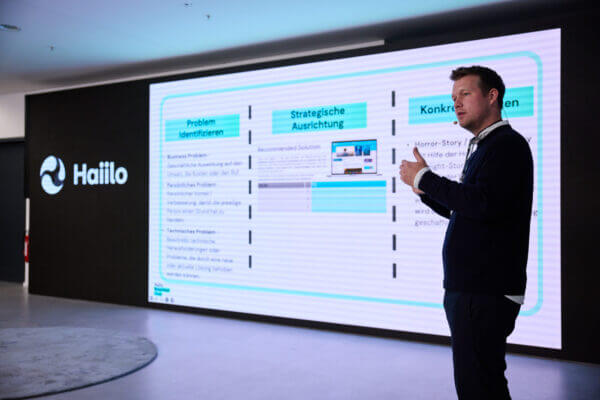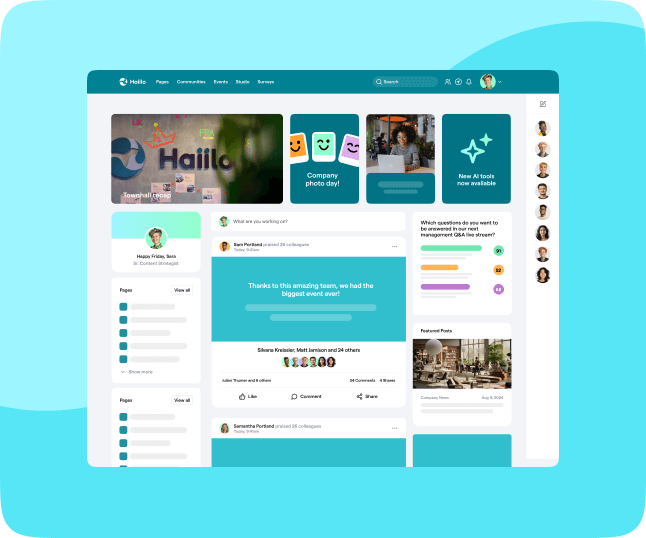Employee engagement is suffering.
Just think about the last time you felt truly connected at work. Maybe a manager praised you in front of your team. Perhaps you laughed with a colleague over coffee. Or you felt that your work really mattered.
They’re important moments, and they’re all too rare.
Managers are juggling too many priorities, teams are spread across cities or even countries, and half your communication happens in Slack threads that vanish before you can find them again. No wonder so many people are quietly checking out.
Gallup’s State of the Global Workforce Report shows that global engagement has slipped to 21%, down from 23% just a year before. That’s not just a number, it’s millions of people feeling unseen, unheard, and uninspired. And the ripple effect is massive: lost productivity, low morale, and a sense of culture drifting away.

For HR and internal comms leaders, the message is loud and clear: the modern workplace has changed, and our approach to engagement needs to change with it.
So, what actually works? Let’s explore the tools that are breathing life back into employee engagement, how they help, why they matter right now, and the difference you’ll see when they’re done well.
1. Pulse surveys and feedback tools
How they help
Gone are the days when you could wait for the annual engagement survey. Employees don’t want to fill out a 45-minute form and hear nothing back for six months.
Modern tools like Officevibe let you send quick “pulse” surveys, gather feedback in real time, and actually respond to what people are saying.
Why now?
When workforces are scattered across hybrid and remote setups, leaders can’t rely on gut instinct. People are disengaging quietly, and you won’t spot it in a Zoom call.
Pulse tools give managers eyes and ears on how their team is really doing (before it’s too late).
What will change?
Employees start to believe their voices matter. Managers stop guessing and start acting. And the organization as a whole shifts from reactive to responsive.
2. Social intranets and communication hubs
How they help
An intranet used to be a dusty bulletin board no one checked. Today, the best intranets look and feel like a social network for your company. It’s where news lives, people connect across teams, and culture has a digital home.
Why now?
With inboxes overflowing and Teams messages flying, employees crave a single place they can trust. A space that isn’t just functional, but actually enjoyable to use.
What will change?
Instead of missing important updates or feeling left out, employees log in and feel genuinely informed. Communities spring up organically. That intranet becomes not a chore, but a habit.
💡 Read: The 2025 guide to building an intranet
3. Recognition tools
How they help
We all know recognition matters, but it often falls to the bottom of the list when managers are stretched. Recognition tools make it easy to give “kudos,” shout-outs, or even simple emoji reactions that say: I see you. I value you.
Why now?
In a world where burnout is rising and employees often feel invisible behind a laptop screen, recognition is fuel.
What will change?
Those little moments of appreciation add up. A culture of gratitude grows. Employees don’t just work for a paycheck, they work because they feel valued.
💡 Read: The 2025 guide to building good culture
4. Employee advocacy platforms
How they help
Advocacy tools let employees share company updates on LinkedIn or Instagram, turning them into authentic brand ambassadors. It’s not about forcing corporate messaging; it’s about giving employees a voice.
Why now?
Your employer brand is more important than ever. People want to work for companies where employees are proud to tell their stories. Advocacy connects the inside and the outside in a way that feels natural.
What will change?
Internally, people feel connected to purpose. Externally, your company looks like it really is: a place where employees believe in the work they do.
💡 Read: How marketing can retain credibility in a skeptical age
5. Analytics and insight tools
How they help
Sometimes, leaders don’t need more data, they need clearer insights. Modern analytics tools track sentiment, spot engagement risks, and even surface recommendations. Think of it as engagement with x-ray vision.
Why now?
The workplace is moving too fast for guesswork. Leaders can’t afford to wait until turnover spikes or Glassdoor reviews tank.
What will change?
Instead of acting after the damage is done, leaders can see disengagement brewing and step in proactively.
The adoption challenge no one talks about
Even the best tools fail if no one uses them. Low adoption is one of the biggest roadblocks HR and comms leaders face. Sometimes it’s because the tech is clunky. Sometimes it’s because employees are already overwhelmed. Sometimes it’s just because no one explained why it matters.
The solution is to bring tools that are intuitive, mobile-friendly, and designed for real humans – not just tech teams. When employees can log in easily, find what they need, and see immediate value, adoption follows.
💡 Read: How adoption is killing employee engagement (and what to do about it)

Why one platform is better than ten tools
Now for the catch: most organizations already have too many tools. A survey app here, a recognition platform there, an advocacy add-on, a legacy intranet. It’s no wonder adoption is low and engagement feels fractured.
Employees don’t want to jump between five apps to feel connected. They want one home base. One login. One space that ties it all together.
That’s where a unified platform makes the difference. Instead of scattering engagement across tools, you create a single hub where feedback, recognition, news, and advocacy live side by side. And suddenly, engagement feels natural again.
💡 Read: The cost of digital fragmentation – and how digital consolidation can save you
How Haiilo brings it all together
This is where Haiilo shines. It isn’t another point solution to add to the pile. It’s a digital home designed to unite engagement tools into one seamless experience.
- Communication: A social intranet where people actually want to spend time.
- Feedback: Quick surveys and sentiment checks, with insights leaders can act on.
- Recognition: Kudos and reactions built right into the flow of work.
- Advocacy: Safe, easy ways for employees to share stories externally.
- Adoption: Intuitive, mobile, and built for real-world employees, not just office workers.
With Haiilo, you don’t just tick the engagement box, you create a living, breathing culture that people feel part of.
💡 Read: How Haiilo delivers real business impact
Employee engagement is about people. Tools are only as powerful as the connections they create. Right now, employees are telling us they want to be heard, recognized, and connected.
The smartest organizations aren’t just throwing more apps at the problem. They’re creating one place where everything comes together. A digital home where culture, communication, and community thrive.
That’s what Haiilo makes possible. And at a time when engagement is at its lowest in years, that feels less like a nice-to-have and more like a lifeline.





